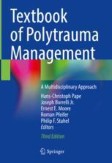Search
Search Results
-
Fracture-Related Infections
Fracture-related infections are a challenging group of complications that vary from 1% after treating a close-low-energy fracture to over 30% in...
-
Fracture-related infection
Musculoskeletal trauma leading to broken and damaged bones and soft tissues can be a life-threating event. Modern orthopaedic trauma surgery,...

-
Costs of fracture-related infection: the impact on direct hospital costs and healthcare utilisation
PurposeFracture-Related Infection (FRI) is associated with high medical costs and prolonged healthcare utilization. However, limited data is...

-
Key aspects of soft tissue management in fracture-related infection: recommendations from an international expert group
A judicious, well-planned bone and soft tissue debridement remains one of the cornerstones of state-of-the-art treatment of fracture-related...

-

-
Comparative analysis of pathogen distribution in patients with fracture-related infection and periprosthetic joint infection: a retrospective study
BackgroundThe purpose of this study is to investigate the microbial patterns of periprosthetic joint infection (PJI) and fracture-related infection...

-
Which non-infection related risk factors are associated with impaired proximal femur fracture healing in patients under the age of 70 years?
Background/purposeImpaired healing is a feared complication with devastating outcomes for each patient. Most studies focus on geriatric fracture...
-
Complications associated with single-level bone transport for the treatment of tibial bone defects caused by fracture-related infection
BackgroundThe purpose of this study was to report the outcomes of single-level bone transport with a unilateral external fixator for treatment of...

-
Treatment of Fracture-Related Infections
Fracture-related infection (FRI) is a serious complication after fracture fixation and imposes a considerable burden on patients and health care...
-
Establishment and application of TSDPSO-SVM model combined with multi-dimensional feature fusion method in the identification of fracture-related infection
Fracture-related infection (FRI) is one of the most common and intractable complications in orthopedic trauma surgery. This complication can impose...

-
Fracture related infection (FRI) of the upper extremity correlates with poor bone and soft tissue healing
PurposeThe purpose of this study was to evaluate the specific course and complication profile following the development of FRI in the upper extremity.
...
-
Analyzing risk factors for treatment failure in fracture-related infection
IntroductionFracture-related infection (FRI) represents a challenging clinical scenario. Limited evidence exists regarding treatment failure after...
-
Intramedullary application of local antibiotic bullets for the treatment of long bone fracture related infection
PurposeThe optimal means of local antibiotic delivery for fracture related infection is unknown. Until now, intramedullary application of calcium...

-
Compassionate use of cefiderocol in a complex case of extensively drug-resistant Acinetobacter baumannii fracture-related infection: a comprehensive approach and multidisciplinary management
PurposeFracture-related infections (FRI) pose a difficult management problem, as they require numerous surgical interventions and extended antibiotic...

-
Analysis of fracture-related infections from Swedish insurance claims between 2011 and 2021
Fracture-related infections (FRI) pose a serious complication with an incidence of 1–2%. This study aimed to analyze compensation claims submitted to...

-
Type of antibiotic but not the duration of prophylaxis correlates with rates of fracture-related infection
PurposeThe issue of optimal prophylactic antibiotic administration for closed and open fracture surgeries remains controversial. The purpose of this...
-
Bifocal versus trifocal bone transport for the management of tibial bone defects caused by fracture-related infection: a meta-analysis
BackgroundThe purpose of this meta-analysis was to compare the efficacy and outcomes of bifocal bone transport (BFT) and trifocal bone transport...

-
Predictors of lower extremity fracture-related amputation in persons with traumatic spinal cord injury: a case–control study
Study designThis is a retrospective case–control study.
ObjectivesTo identify predictors of lower extremity (LE) long bone fracture-related...

-
Prior use of antibiotics and immunosuppression are risk factors for fracture-related infection during the COVID-19 pandemic period: a Brazilian prospective cohort study
BackgroundLittle is known about the role of COVID-19 pandemic period on the epidemiology of fracture-related infection (FRI). The present study...

-
Outcome of multi-staged induced membrane technique based on post-debridement cultures for the management of critical-sized bone defect following fracture-related infection
The authors’ institution utilizes multi-staged induced membrane technique protocol based on post-debridement culture in treating patients with...

